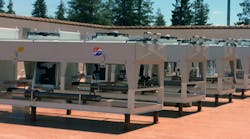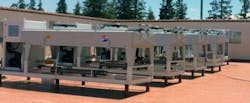The Whole Foods Market store in Santa Clara, Calif., opened its doors to customers in late July, with what sources describe as “the most environmentally-advanced grocery retail refrigeration system in the U.S.”
The installation comes at a time when California is looking to significantly reduce emissions of all greenhouse gases, including hydrofluorocarbons (HFCs) used in refrigeration systems.
The system used in the Santa Clara store eliminates all direct greenhouse gas emissions from refrigeration, thereby preventing the more than 7,000 metric tons of CO2 equivalent that a typical supermarket emits every year, which is more than the entire annual electricity use of over 1,000 homes.
Whole Foods Market’s Hydrocarbon/CO2 Cascade System reduces the environmental impacts of refrigerants to near-zero, while greatly improving energy efficiency. It uses propane to condense CO2. The CO2 is then piped through refrigeration systems to keep products cool. With high heat carrying properties, the use of CO2 reduces both the amount of refrigerant needed and the energy required to run refrigeration systems. Simultaneously, a heat reclaim system captures the heat generated by the system, and uses it to preheat water for the store’s later use, while also supplementing space heating. This allows the store to greatly reduce the amount of natural gas burned to heat water.
The U.S. Environmental Protection Agency recently banned the use of some common refrigerants such as R-404A and R-507A for new installations and retrofits, due to their what many say is their adverse climate impact. In July, the parties to the Montreal Protocol met to negotiate a worldwide plan to eliminate the use of other harmful refrigerant gases over time. California has been at the forefront of efforts to reduce refrigeration emissions, with rules in place that are being adopted nationally, and proposed efforts to further reduce emissions from these sources, in line with Governor Jerry Brown’s directive for the state to reduce its greenhouse gas emissions 40% below 1990 levels by 2030.










